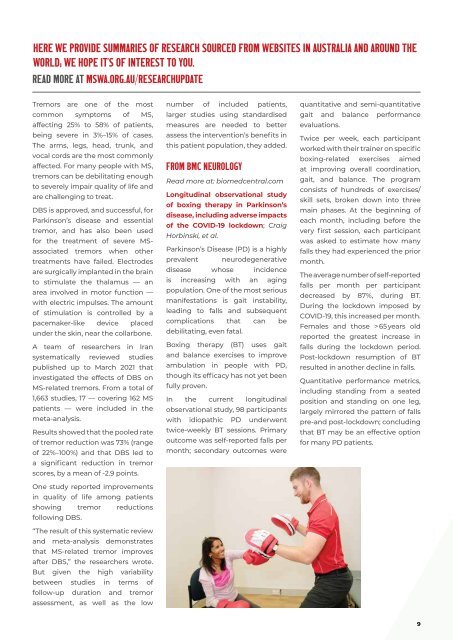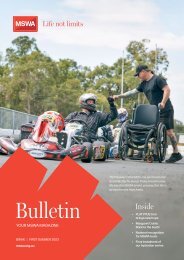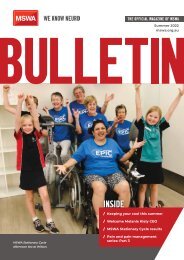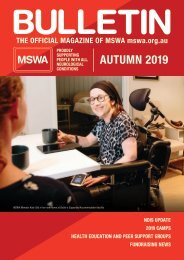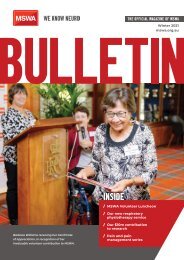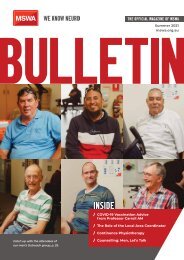MSWA Bulletin Magazine Spring 2021
What is assistive technology and how can it help you? | Good health monitoring practices | Pain and pain management series: Part 2 | Farewell Marcus Stafford
What is assistive technology and how can it help you? | Good health monitoring practices | Pain and pain management series: Part 2 | Farewell Marcus Stafford
Create successful ePaper yourself
Turn your PDF publications into a flip-book with our unique Google optimized e-Paper software.
HERE WE PROVIDE SUMMARIES OF RESEARCH SOURCED FROM WEBSITES IN AUSTRALIA AND AROUND THE<br />
WORLD; WE HOPE IT’S OF INTEREST TO YOU.<br />
READ MORE AT <strong>MSWA</strong>.ORG.AU/RESEARCHUPDATE<br />
Tremors are one of the most<br />
common symptoms of MS,<br />
affecting 25% to 58% of patients,<br />
being severe in 3%–15% of cases.<br />
The arms, legs, head, trunk, and<br />
vocal cords are the most commonly<br />
affected. For many people with MS,<br />
tremors can be debilitating enough<br />
to severely impair quality of life and<br />
are challenging to treat.<br />
DBS is approved, and successful, for<br />
Parkinson’s disease and essential<br />
tremor, and has also been used<br />
for the treatment of severe MSassociated<br />
tremors when other<br />
treatments have failed. Electrodes<br />
are surgically implanted in the brain<br />
to stimulate the thalamus — an<br />
area involved in motor function —<br />
with electric impulses. The amount<br />
of stimulation is controlled by a<br />
pacemaker-like device placed<br />
under the skin, near the collarbone.<br />
A team of researchers in Iran<br />
systematically reviewed studies<br />
published up to March <strong>2021</strong> that<br />
investigated the effects of DBS on<br />
MS-related tremors. From a total of<br />
1,663 studies, 17 — covering 162 MS<br />
patients — were included in the<br />
meta-analysis.<br />
Results showed that the pooled rate<br />
of tremor reduction was 73% (range<br />
of 22%–100%) and that DBS led to<br />
a significant reduction in tremor<br />
scores, by a mean of -2.9 points.<br />
One study reported improvements<br />
in quality of life among patients<br />
showing tremor reductions<br />
following DBS.<br />
“The result of this systematic review<br />
and meta-analysis demonstrates<br />
that MS-related tremor improves<br />
after DBS,” the researchers wrote.<br />
But given the high variability<br />
between studies in terms of<br />
follow-up duration and tremor<br />
assessment, as well as the low<br />
number of included patients,<br />
larger studies using standardised<br />
measures are needed to better<br />
assess the intervention’s benefits in<br />
this patient population, they added.<br />
FROM BMC NEUROLOGY<br />
Read more at: biomedcentral.com<br />
Longitudinal observational study<br />
of boxing therapy in Parkinson’s<br />
disease, including adverse impacts<br />
of the COVID-19 lockdown; Craig<br />
Horbinski, et al.<br />
Parkinson’s Disease (PD) is a highly<br />
prevalent neurodegenerative<br />
disease whose incidence<br />
is increasing with an aging<br />
population. One of the most serious<br />
manifestations is gait instability,<br />
leading to falls and subsequent<br />
complications that can be<br />
debilitating, even fatal.<br />
Boxing therapy (BT) uses gait<br />
and balance exercises to improve<br />
ambulation in people with PD,<br />
though its efficacy has not yet been<br />
fully proven.<br />
In the current longitudinal<br />
observational study, 98 participants<br />
with idiopathic PD underwent<br />
twice-weekly BT sessions. Primary<br />
outcome was self-reported falls per<br />
month; secondary outcomes were<br />
quantitative and semi-quantitative<br />
gait and balance performance<br />
evaluations.<br />
Twice per week, each participant<br />
worked with their trainer on specific<br />
boxing-related exercises aimed<br />
at improving overall coordination,<br />
gait, and balance. The program<br />
consists of hundreds of exercises/<br />
skill sets, broken down into three<br />
main phases. At the beginning of<br />
each month, including before the<br />
very first session, each participant<br />
was asked to estimate how many<br />
falls they had experienced the prior<br />
month.<br />
The average number of self-reported<br />
falls per month per participant<br />
decreased by 87%, during BT.<br />
During the lockdown imposed by<br />
COVID-19, this increased per month.<br />
Females and those > 65 years old<br />
reported the greatest increase in<br />
falls during the lockdown period.<br />
Post-lockdown resumption of BT<br />
resulted in another decline in falls.<br />
Quantitative performance metrics,<br />
including standing from a seated<br />
position and standing on one leg,<br />
largely mirrored the pattern of falls<br />
pre-and post-lockdown; concluding<br />
that BT may be an effective option<br />
for many PD patients.<br />
9


